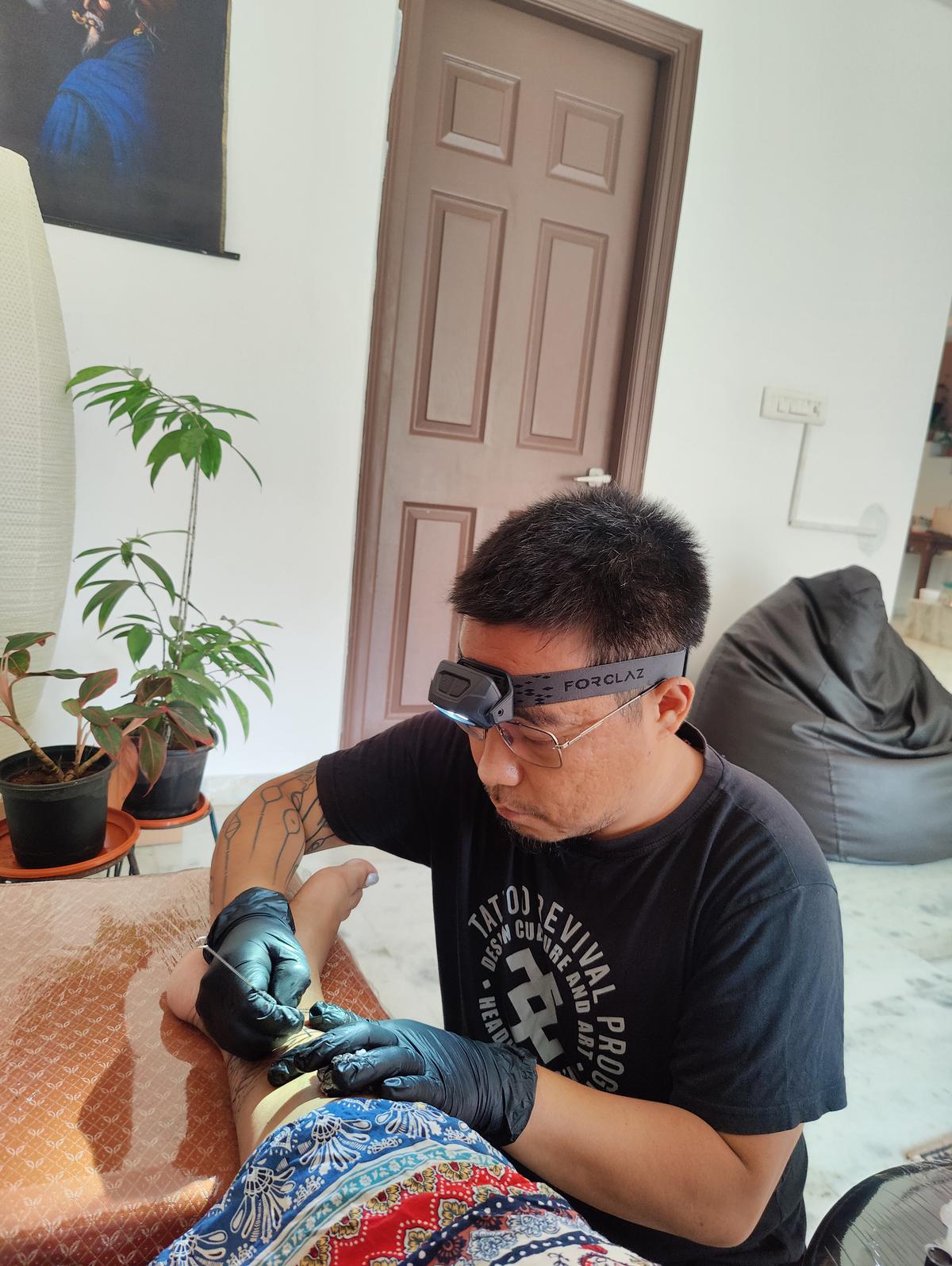Morangam Khaling, popularly known as Mo Naga, was all set to pursue a career in fashion design after being trained at the National Institute of Fashion Technology (NIFT) in 2004. This was during the discovery of various mediums such as Plaster of Paris (POP). The thought of wood, chalk, cloth etc. during his first year at NIFT made him wonder why the skin was left out. After a brief discussion with his project partner, he decided to explore tattooing.
An independent researcher and revivalist of India’s traditional art and design culture with a focus on Naga tattoos, Mo is currently based in Hyderabad at Rock Bottom, a private cultural space in Banjara Hills. Taking a break from consultations with his clients, he sets out to prepare his equipment and have a quick chat. Known for his expertise in handmade tattoos, Moe recalls that day in 2004: “My project partner and I went to Secunderabad and bought a tattoo machine. Before we could even open the machine, three of our classmates were ready to get tattoos. I’ve never had a tattoo before. However, my friends insisted that they believed in my paintings (my classmates were big fans of my sketch work, especially the sculptures and motifs). I got tattooed for the first time. After a time, I stopped because I wanted to learn about the healing process, healing, and all other aspects of the art.
Taping Tattoo with Peetei | photo credit: special arrangement
Mo works freehand without a stencil; Sometimes his needle is a pen and the skin becomes a canvas. “When I understand my client’s requirements and I explain what I am going to do, I have patterns printed in my mind. Sometimes I don’t even make a sketch,” he elaborates.
After being trained in fashion design, Moe also began to learn about tattoos as a culture. It was a challenge as they did not find much material on the subject. During his search, he found pictures of old Nagas with tattoos and decided to focus on tribal tattoos of the Northeast. “There is research on different cultures in foreign universities but information about tattoos is lacking. People studied culture without reference to tattoos, which are an important part of culture.”
After gaining enough knowledge and understanding of tattooing as an art form, Moe decided to start tattooing to sustain himself. As a tattoo artist, he has a reason to make a tribal tattoo on his client. “Tattoos on our elderly people are symbols of either their achievements, their clan, to ward off evil or anything else that is important to them. Tattoos are different for men and women. Tattooing someone just because they like the design or pattern is wrong. When I get tattoos inspired by Naga culture, it means I take inspiration from it. Culture includes clothing, food, language, music, etc. and it is all a result of the surroundings that make up a community. My tattoos have all these elements and the nature that I am surrounded by.”
In this way Mo is not only promoting but also preserving an ancient art form. Also, he started doing hand tattoos to draw attention to the culture. “There can’t be a better way to get people curious about this art and the work of preserving traditional tattoos,” he said.
Mo, however, says that his true craft is taping tattoos (hand-tapped tattoos are a traditional tattoo method, using only thorns attached to a stick) to inject ink inside the skin. For which they have a long waiting list of customers. Yet he won’t do it anywhere. “In 2015, when I learned to tattoo and was allowed to practice it by a practicing PT in Singha Chingu village in Nagaland, it was a ceremony. On that day 82-year-old Pete (also the queen of the village) took out her kit after 60 years and we got tattooed together. For something so sacred to that community, I don’t want to do it anywhere because someone wants to pay for it. Everything about it, starting with the tools, is considered sacred and derived from nature, so I like to do it in an area where one can personally observe the process with the right tools and ink. There, ink is extracted from leaves that have healing properties and the needles are a bunch of thorns from various citrus fruit trees. ,
Use of rattan thorn in tattoo making. photo credit: Mo Naga

Mo Naga at work at Rock Bottom | photo credit: special arrangement
Recently, Mo spends most of his time developing Tattoo Village in Manipur where everything (knowledge of tattoos) is freely available to all. In the village, he will teach traditional tattoos and indigenous tools in need. “The village has all the plants and trees that are needed for tattoo ink, traditional tattoo tools, and plants and herbs used in healing.”